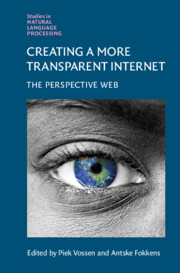Refine search
Actions for selected content:
3312 results in Artificial Intelligence and Natural Language Processing
A survey of methods for revealing and overcoming weaknesses of data-driven Natural Language Understanding
-
- Journal:
- Natural Language Engineering / Volume 29 / Issue 1 / January 2023
- Published online by Cambridge University Press:
- 22 April 2022, pp. 1-31
-
- Article
-
- You have access
- Open access
- HTML
- Export citation

Creating a More Transparent Internet
-
- Published online:
- 21 April 2022
- Print publication:
- 05 May 2022
NLE volume 28 issue 3 Cover and Front matter
-
- Journal:
- Natural Language Engineering / Volume 28 / Issue 3 / May 2022
- Published online by Cambridge University Press:
- 08 April 2022, pp. f1-f2
-
- Article
-
- You have access
- Export citation
NLE volume 28 issue 3 Cover and Back matter
-
- Journal:
- Natural Language Engineering / Volume 28 / Issue 3 / May 2022
- Published online by Cambridge University Press:
- 08 April 2022, pp. b1-b2
-
- Article
-
- You have access
- Export citation
The voice synthesis business: 2022 update
-
- Journal:
- Natural Language Engineering / Volume 28 / Issue 3 / May 2022
- Published online by Cambridge University Press:
- 08 April 2022, pp. 401-408
-
- Article
-
- You have access
- Open access
- HTML
- Export citation
Real-world sentence boundary detection using multitask learning: A case study on French
-
- Journal:
- Natural Language Engineering / Volume 30 / Issue 1 / January 2024
- Published online by Cambridge University Press:
- 06 April 2022, pp. 150-170
-
- Article
-
- You have access
- Open access
- HTML
- Export citation
Gender bias in legal corpora and debiasing it
-
- Journal:
- Natural Language Engineering / Volume 29 / Issue 2 / March 2023
- Published online by Cambridge University Press:
- 30 March 2022, pp. 449-482
-
- Article
- Export citation
Generating Arabic TAG for syntax-semantics analysis
-
- Journal:
- Natural Language Engineering / Volume 29 / Issue 2 / March 2023
- Published online by Cambridge University Press:
- 24 March 2022, pp. 386-424
-
- Article
- Export citation
In-depth analysis of the impact of OCR errors on named entity recognition and linking
-
- Journal:
- Natural Language Engineering / Volume 29 / Issue 2 / March 2023
- Published online by Cambridge University Press:
- 18 March 2022, pp. 425-448
-
- Article
- Export citation
Explainable lexical entailment with semantic graphs
-
- Journal:
- Natural Language Engineering / Volume 29 / Issue 5 / September 2023
- Published online by Cambridge University Press:
- 28 February 2022, pp. 1223-1246
-
- Article
-
- You have access
- Open access
- HTML
- Export citation
MHeTRep: A multilingual semantically tagged health terms repository
-
- Journal:
- Natural Language Engineering / Volume 29 / Issue 5 / September 2023
- Published online by Cambridge University Press:
- 25 February 2022, pp. 1364-1401
-
- Article
-
- You have access
- Open access
- HTML
- Export citation
Enhancing deep neural networks with morphological information
-
- Journal:
- Natural Language Engineering / Volume 29 / Issue 2 / March 2023
- Published online by Cambridge University Press:
- 21 February 2022, pp. 360-385
-
- Article
- Export citation
An empirical study of cyclical learning rate on neural machine translation
-
- Journal:
- Natural Language Engineering / Volume 29 / Issue 2 / March 2023
- Published online by Cambridge University Press:
- 09 February 2022, pp. 316-336
-
- Article
- Export citation
NLE volume 28 issue 2 Cover and Back matter
-
- Journal:
- Natural Language Engineering / Volume 28 / Issue 2 / March 2022
- Published online by Cambridge University Press:
- 08 February 2022, pp. b1-b2
-
- Article
-
- You have access
- Export citation
Emerging Trends: SOTA-Chasing
-
- Journal:
- Natural Language Engineering / Volume 28 / Issue 2 / March 2022
- Published online by Cambridge University Press:
- 08 February 2022, pp. 249-269
-
- Article
-
- You have access
- Open access
- HTML
- Export citation
NLE volume 28 issue 2 Cover and Front matter
-
- Journal:
- Natural Language Engineering / Volume 28 / Issue 2 / March 2022
- Published online by Cambridge University Press:
- 08 February 2022, pp. f1-f2
-
- Article
-
- You have access
- Export citation
Towards improving the robustness of sequential labeling models against typographical adversarial examples using triplet loss
-
- Journal:
- Natural Language Engineering / Volume 29 / Issue 2 / March 2023
- Published online by Cambridge University Press:
- 04 February 2022, pp. 287-315
-
- Article
- Export citation
SoundexGR: An algorithm for phonetic matching for the Greek language
-
- Journal:
- Natural Language Engineering / Volume 29 / Issue 5 / September 2023
- Published online by Cambridge University Press:
- 04 February 2022, pp. 1305-1340
-
- Article
-
- You have access
- Open access
- HTML
- Export citation
Towards improving coherence and diversity of slogan generation
-
- Journal:
- Natural Language Engineering / Volume 29 / Issue 2 / March 2023
- Published online by Cambridge University Press:
- 04 February 2022, pp. 254-286
-
- Article
- Export citation
Topical language generation using transformers
-
- Journal:
- Natural Language Engineering / Volume 29 / Issue 2 / March 2023
- Published online by Cambridge University Press:
- 04 February 2022, pp. 337-359
-
- Article
- Export citation



